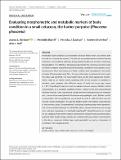Files in this item
Evaluating morphometric and metabolic markers of body condition in a small cetacean, the harbor porpoise (Phocoena phocoena)
Item metadata
| dc.contributor.author | Kershaw, Joanna L. | |
| dc.contributor.author | Sherrill, Meredith | |
| dc.contributor.author | Davison, Nicholas J. | |
| dc.contributor.author | Brownlow, Andrew | |
| dc.contributor.author | Hall, Ailsa J. | |
| dc.date.accessioned | 2017-04-10T09:30:14Z | |
| dc.date.available | 2017-04-10T09:30:14Z | |
| dc.date.issued | 2017-05 | |
| dc.identifier | 249242474 | |
| dc.identifier | e83da80b-41e4-4f45-bb13-b01b82568b81 | |
| dc.identifier | 85017647999 | |
| dc.identifier | 000402554700019 | |
| dc.identifier.citation | Kershaw , J L , Sherrill , M , Davison , N J , Brownlow , A & Hall , A J 2017 , ' Evaluating morphometric and metabolic markers of body condition in a small cetacean, the harbor porpoise ( Phocoena phocoena ) ' , Ecology and Evolution , vol. 7 , no. 10 , pp. 3494-3506 . https://doi.org/10.1002/ece3.2891 | en |
| dc.identifier.issn | 2045-7758 | |
| dc.identifier.other | ORCID: /0000-0002-7562-1771/work/47136268 | |
| dc.identifier.uri | https://hdl.handle.net/10023/10598 | |
| dc.description | The authors would like to thank the funders; the Department for Environment Food and Rural Affairs (DEFRA) and Marine Scotland for a number of long term monitoring contracts awarded to the Scottish Marine Animal Strandings Scheme, the Sea Mammal Research Unit National Capability Funding from the Natural Environment Research Council (NERC) and the University of St. Andrews Masters in Marine Mammal Science program. | en |
| dc.description.abstract | Mammalian body condition is an important individual fitness metric as it affects both survival and reproductive success. The ability to accurately measure condition has key implications for predicting individual and population health, and therefore monitoring the population-level effects of changing environments. No consensus currently exists on the best measure to quantitatively estimate body condition in many species, including cetaceans. Here, two measures of body condition were investigated in the harbor porpoise (Phocoena phocoena). First, the most informative morphometric body condition index was identified. The mass/length2 ratio was the most appropriate morphometric index of 10 indices tested, explaining 50% of the variation in condition in stranded, male porpoises with different causes of death and across age classes (n = 291). Mass/length2 was then used to evaluate a second measure, blubber cortisol concentration, as a metabolic condition marker. Cortisol is the main glucocorticoid hormone involved in the regulation of lipolysis and overall energy balance in mammals, and concentrations could provide information on physiological state. Blubber cortisol concentrations did not significantly vary around the girth (n = 20), but there was significant vertical stratification through the blubber depth with highest concentrations in the innermost layer. Concentrations in the dorsal, outermost layer were representative of concentrations through the full blubber depth, showed variation by sex and age class, and were negatively correlated with mass/length2. Using this species as a model for live cetaceans from which standard morphometric measurements cannot be taken, but from which blubber biopsy samples are routinely collected, cortisol concentrations in the dorsal, outermost blubber layer could potentially be used as a biomarker of condition in free-ranging animals. | |
| dc.format.extent | 13 | |
| dc.format.extent | 644329 | |
| dc.language.iso | eng | |
| dc.relation.ispartof | Ecology and Evolution | en |
| dc.subject | Blubber biopsies | en |
| dc.subject | Body condition index | en |
| dc.subject | Cetaceans | en |
| dc.subject | Cortisol | en |
| dc.subject | Mass/length2 | en |
| dc.subject | QH301 Biology | en |
| dc.subject | QP Physiology | en |
| dc.subject | NDAS | en |
| dc.subject.lcc | QH301 | en |
| dc.subject.lcc | QP | en |
| dc.title | Evaluating morphometric and metabolic markers of body condition in a small cetacean, the harbor porpoise (Phocoena phocoena) | en |
| dc.type | Journal article | en |
| dc.contributor.sponsor | NERC | en |
| dc.contributor.institution | University of St Andrews. School of Biology | en |
| dc.contributor.institution | University of St Andrews. Sea Mammal Research Unit | en |
| dc.contributor.institution | University of St Andrews. Scottish Oceans Institute | en |
| dc.contributor.institution | University of St Andrews. Marine Alliance for Science & Technology Scotland | en |
| dc.identifier.doi | 10.1002/ece3.2891 | |
| dc.description.status | Peer reviewed | en |
| dc.date.embargoedUntil | 2017-04-09 | |
| dc.identifier.grantnumber | Agreement R8-H12-86 | en |
This item appears in the following Collection(s)
Items in the St Andrews Research Repository are protected by copyright, with all rights reserved, unless otherwise indicated.

